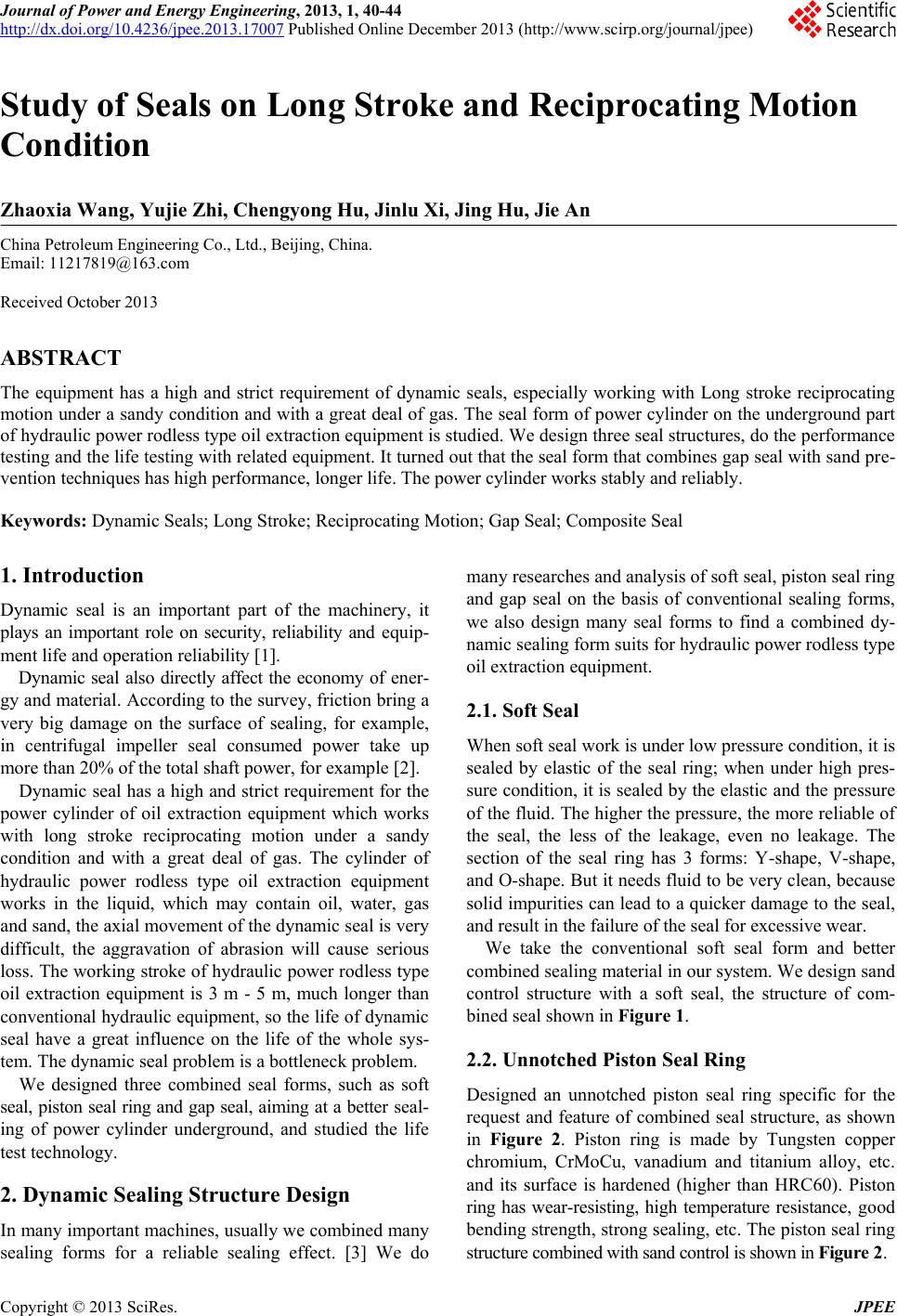
Journal of Power and Energy Engineering, 2013, 1, 40-44
http://dx.doi.org/10.4236/jpee.2013.17007 Published Online December 2013 (http://www.scirp.org/journal/jpee)
Copyright © 2013 SciRes. JPEE
Study of Seals on Long Stroke and Reciprocating Motion
Condition
Zhaoxia Wang, Yujie Zhi, Chengyong Hu, Jinlu Xi, Jing Hu, Jie An
China Petroleum Engineering Co., Ltd., Beijing, China.
Email: 11217819@163.com
Received October 2013
ABSTRACT
The equipment has a high and strict requirement of dynamic seals, especially working with Long stroke reciprocating
motion under a sandy condition and with a great deal of gas. The seal form of power cylinder on the underground part
of hydrau lic pow er rod less type oil extraction equipment is studied. We design three seal structures, do the performance
testing and the life testing w ith related equipment. It turn ed out that the seal fo rm that combines gap seal with sa nd pr e-
vention te chniques has hig h pe rform ance, longer life. The power cylinder works stably and reliably.
Keywords: Dynamic Seals; Long Stroke; Reciprocating Motion; Gap Seal; Composite Seal
1. Introduction
Dynamic seal is an important part of the machinery, it
plays an important role on security, reliability and equip-
ment life and operation reliability [1].
Dynamic seal also directly affect the economy of ener-
gy and material. According to the survey, friction bring a
very big damage on the surface of sealing, for example,
in centrifugal impeller seal consumed power take up
more than 20% of the total shaft power, for example [2].
Dynamic seal has a high and strict requirement for the
power cylinder of oil extraction equipment which works
with long stroke reciprocating motion under a sandy
condition and with a great deal of gas. The cylinder of
hydraulic power rodless type oil extraction equipment
works in the liquid, which may contain oil, water, gas
and sand, the axial movement of the dynamic seal is very
difficult, the aggravation of abrasion will cause serious
loss. The working stroke of hydraulic power rodless type
oil extraction equipment is 3 m - 5 m, much longer than
conventional hydraulic equipment, so the life of dynamic
seal have a great influence on the life of the whole sys-
tem. The dynamic seal problem is a bottleneck problem.
We designed three combined seal forms, such as soft
seal, piston seal ring and gap seal, aiming at a better seal-
ing of power cylinder underground, and studied the life
test technology.
2. Dynamic Sealing Structure Design
In many important machines, usually we combined many
sealing forms for a reliable sealing effect. [3] We do
many researches and analysis of soft seal, piston seal ring
and gap seal on the basis of conventional sealing forms,
we also design many seal forms to find a combined dy-
namic sealing form suits for hydraulic power rodless type
oil extraction equipment.
2.1. Soft Seal
When soft seal work is under low pre ssure condition, it is
sealed by elastic of the seal ring; when under high pres-
sure condition, it is sealed by the elastic and the pressure
of the fluid. The higher the pressure, the more reliable of
the seal, the less of the leakage, even no leakage. The
section of the seal ring has 3 forms: Y-shape, V-shape,
and O-shape. But it needs fluid to be very clean, because
solid impurities can lead to a quicker damage to the seal,
and result in the failure of the seal for excessive wear.
We take the conventional soft seal form and better
combined sealing material in our system. We design sand
control structure with a soft seal, the structure of com-
bined seal shown in Figure 1.
2.2. Unnotched Piston Seal Ring
Designed an unnotched piston seal ring specific for the
request and feature of combined seal structure, as shown
in Figure 2. Piston ring is made by Tungsten copper
chromium, CrMoCu, vanadium and titanium alloy, etc.
and its surface is hardened (higher than HRC60). Piston
ring has wear-resisting, high temperature resistance, good
bending strength , strong sealing, etc. The piston seal r ing
structure combined with sand control is shown in Figure 2.